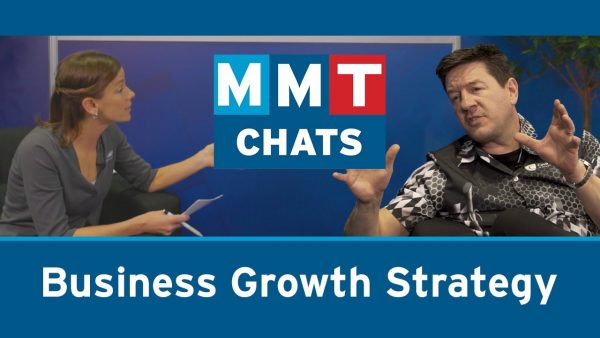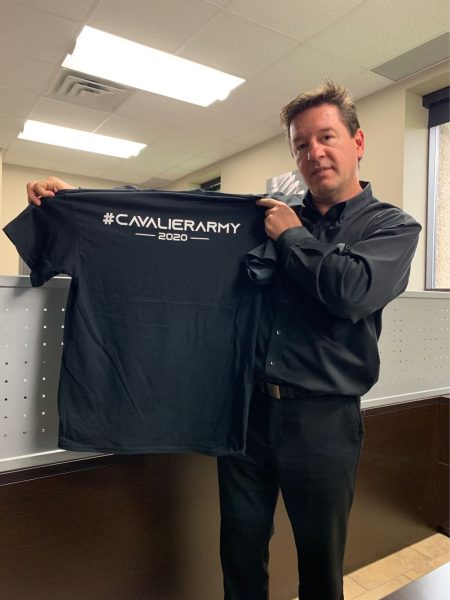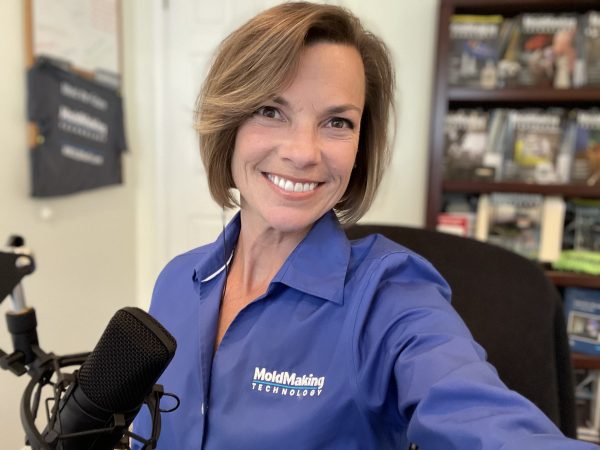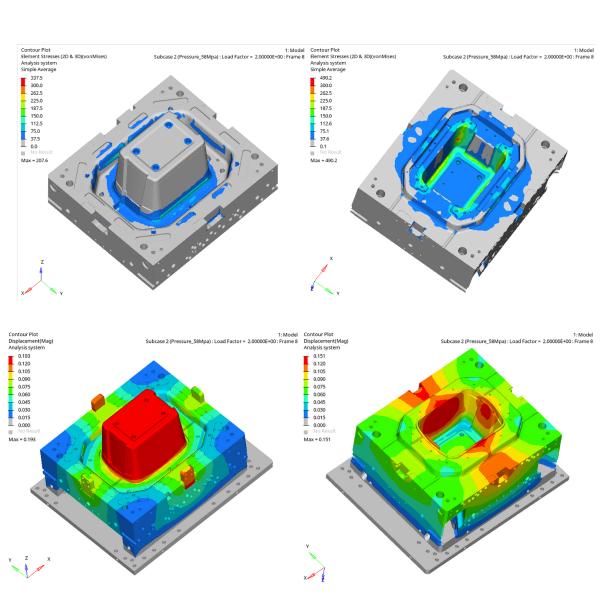Cavalier makes presence known: Get to market quickly with top quality and value
Published Nov 29, 2022 | Posted in Culture, Manufacturing, News
“My grandfather was a blacksmith. My father started off in the business, actually on the day I was born. And my whole family was in the mold making business per se. My grandfather, like I said, was a blacksmith. So, my father started it all and I was introduced at a very young age and so I started when I was 15 years old in the tool shop and sweeping floors …”
Brian Bendig
Cavalier Tool and Manufacturing President, Brian Bendig was interviewed as part of MMT Chats, with Moldmaking Technology and Christina Fuges, to talk about Growing a Moldmaking Workforce.
“We make things for people to make things and we create things that no one else has. So, everything we do is new and unique. It’s a one-off, we do stuff that no one sees. And it’s kind of cool that we will start today and the products we make you’ll see in two years from now.”
People Process Equipment: The Cavalier Way.
Bendig told MMT Chats that getting a product to market quickly is often of great value to many of their clients – and delays mean higher costs, so Cavalier saw an opportunity in a Speed-to-Market approach to their business in plastic injection molding.
Their approach has also made growing their workforce a challenge, but one that also helps attract people who want to be part of the winning team, known as the #CavalierArmy.
Supply chain issues have been a problem, but it applies across the board, to competitors, so now it is a matter of how Cavalier can still find workarounds and ways to deliver quality tools quicker than many other mold makers in the plastic injection molding industry.
Setting up shop in India – now with three locations – Cavalier is designing 24 hours a day; sometimes even more with the double shifts.
“We can improve on our design time and get a tool out in sometimes half the time of others, while still maintaining our high quality that we have become known for,” says Bendig.
Bendig says they grew quickly during the pandemic, which also has to do with their agile approach to business. Cavalier didn’t see the pandemic as a problem, but instead saw it as an opportunity to fine-tune and also, were able to move quickly to a work-at-home strategy and also bring in safety protocols, while even purchasing another business.
Cavalier grew by almost 50 percent. “We were outsourcing well over $10 million, because we just couldn’t build it. So, we bought a company called MSI Mold Services International in Oldcastle, Ontario. We had a relationship, we did a lot of work with those guys for a number of years, so we’re friendly and familiar.
There were five things we needed. We needed the roughing, EDM, gun, drill five axis and components. That facility offered all five of those things, so it was a capacity solution. We went in there … and we did it overnight.”
A previous news blog talked about how the purchase of MSI capitalizes on the momentum built over the last 12 months.
Cavalier has made its presence known – locally and internationally – in spite of a pandemic. Investing in people, process and equipment is recognized as “The Cavalier Way” and in turn, it results in success for clients, staff and growth opportunities.
“We want that to continue. We need the capacity to be able to do that,” says Bendig. “And MSI will be another part of that growth strategy.”
In the more recent interview with Christina Fuges, Bendig talked about the onboarding process from the perspective of how we introduce people to our company, but we also have an onboarding process for new customers.
In a previous blog we talked about that. As always, at Cavalier our goal is to find solutions, to grow our Cavalier Army and to also keep ahead of the curve for our clients; both current and future.
Once you have decided that you want to work with Cavalier, our three-step onboarding process looks like this.
- Step 1 – Part Feasibility: Even if your data is not final, let us have a look at it. Our sales team has a dedicated feasibility group that can look for opportunities to optimize your part design. Part designers do not often consider tooling conditions when designing a part. Our team will review the part with a toolmaker’s lens. Cooling, maintenance, and cycle time are all considerations when commencing our Design for Manufacturing (DFM) study. Working on this ‘up-front,’ allows these considerations to be incorporated into the final OTT data release. The detail that these studies include provides the tool designer with a roadmap when the design is started.
The result: shorter build times.
- Step 2 – Flow Simulation: If there are any questions about gating or press size, we can run a mold-filling simulation – using Autodesk Moldflow® – to provide valuable feedback for manifold configuration, gate location and press selection – key data points needed to begin tool design.
The result: shorter build time.
Step 3 – Commercial assessment: When the optimization of the part and tool design concept has been completed, our estimating group will revisit the proposed cost and timing and then provide an accurate project quote, along with any added or removed content that would drive the cost. If the project start date has been determined, we can then enter the breakdown into our manufacturing schedule to validate timing to T-1.
The result: shorter build time.
These three critical steps in launching a tool-build are traditionally addressed after project timing has started.
By completing these milestones prior to build-launch, Cavalier can effectively reduce tool-build time – for small and medium tools, we can reduce delivery by up to 25%.
To read more about this part of onboarding, check out our previous blog.
Molds Make a Difference is also part of what MMT talked about at the PTXPO where Brian was interviewed.
So, how would Brian finish the sentence of Molds Make a Difference….
“Molds make things for people to make things …We make molds and people take our product to make something. We’re a little piece of the puzzle. What we do allows people to build bigger and better things.”
-30-
Link to YouTube: https://youtu.be/PIJ4Tt5Ey54
TRANSCRIPT – From Otter.Ai
(Direct transcription– Please excuse errors or omissions)
Welcome to MMT chats. This episode was brought to you by Iscar. With new ideas for machining intelligently.
I’m Christina futures will make you technology and I am here with the president of Cavalier Tool and manufacturing.Brian bending. Hi, Brian.
0:15
Brian:
Hello! . Thank you for having me today.
0:21
Christina:
Good. Let’s tell people who are not familiar with you a little bit about your journey into the plastics and moldmaking community.
Brian:
0:29
Sure. Well, it’s been a long road. So my grandfather was a blacksmith. My father started off in the business actually, the dad was born November 17 1975. As funny as that may sound on my birthday,
And my whole family was in the mold making business per se. My grandfather, like I said, was a blacksmith. So my father started it and I was introduced at a very young age and so I started when I was 15 years old in the in the tool shop and sweeping floors
1:07
Christina:
Now, you probably agree with me, I consider this more of a community than an industry mold making what, what inspires you about this community?
Brian:
1:17
You know, it’s kind of cool, because we make things for people to make things and we create things that no one else has. So everything you do is new, unique. It’s a one off, we do stuff that no one sees. And it’s kind of cool that we will start today and the products we make you’ll see in two years from now. So everyone sees the all new car, the all new whatever it is, when I saw that two years ago, we’re kind of you know, the guys that cut the trail this
Christina
1:42
Yeah, I love it.I haven’t had somebody express it that way. And that is so true. You’re actually ahead of it a little bit. Oh, news to you once it comes out to someone like me, right.
Brian
1:52
And we see a lot of things because we have a ton of products that never get built. So we kind of get introduced to things that you know, don’t eventually make it in the market. But we see all kinds of neat things. Yeah. So it’s unique. It’s fun, we get to play in that sandbox.
Christina
2:05
So let’s talk about Cavalier … I know and most people know, I think if you’re familiar with Cavalier tool, it’s all about people, process and equipment. So that’s obviously working for you. So I want to talk a little bit about the people’s side. And you have, and it’s probably in terms of your customers, I would imagine you have a three step onboarding process. Can you go into that a little bit? Because if you say that it reduces Monville time by 25%. So what do you mean by this onboarding process?
Brian
2:35
Well, I mean, at the end of the day, it comes down to the people, the people get us to the finish line. And without the people we would never get where we’re going. So of course, we look for all kinds of talent, we look for unique individuals. But at the end of the day, it’s the team, it’s always the people, the management, the people behind me that put it all together. And I joke and I say I want to win the Superbowl, I’m the head coach, but it’s the players in the offensive line and the defensive line, all these people get us to that Super Bowl. And at the end of the day, we won the bowl like we did it. And so the onboarding process, I mean, it’s, it’s involved, we take a lot of time to interview people. We train, we do a lot of things within the shop. But it’s the people that get us there. And that’s really what we want. It’s always about the people.
Christina
3:16
Have you had problems finding people?
Brian
3:19
It is difficult, as many people say, but we’re also an interesting company. I think we get more opportunities than most people do. We’ve got a lot of resumes, where I’ve heard of other shops don’t get any. We do a lot of neat things. But the downside of that is that because of who we are, we also get poached. A lot of people try to take our people,
Christina
3:39
you do all the work, and then they take them
Brian
3:41
it seems like you know, we’ve got the latest and greatest equipment. Yeah, different things and processes that other people desire. So we have these people. So as much as people want to jump on the bus, there’s other people trying to take the people off our bus
Christina:
3:54
That’s nothing new, though, is it? Really?
Brian:
3:57
It’s a difficult challenge.
Christina
3:59
What’s interesting, too about you guys, you’ve had a lot of personnel strategies that involve different investments in expanding like, can you talk a little bit about you your latest act was the latest acquisition right? With MSI, and also the India operation. And that was a way of you addressing a workforce issue in a different way. Acquiring right, absolutely something else to talk about those two.
Brian
4:18
So let’s talk about India first. So India, there’s a lot of challenges in our world. And one of the big challenges is typically around when we talk about delays or what prevents us from being successful, it’s often the customer not having the product ready. You can’t get out of the chute as they say you can’t get going. So what does that mean? They’re not ready to launch, you know, you’ll get out your purchase order, but then you’re on hold for months or weeks, whatever that might be. So India for us, we wanted to improve our design, and this is what really starts or launches every program.
Without designing the tool. How do you get going, how do you get out of the box?
So you’ve got to start with that. So what India did for us is it allows us to design so many of our competitors have 10 hours a day, we can design over, you know 20 Sometimes 30 hours a day, we have double shifts in India and a single shift in Canada . So when you put that all together, when a guy needs six weeks to design a tool, we can do it and sometimes two or three. So that becomes very desirable when everyone’s in trouble and they’re panicking and they can’t get off the ground.
We can, you know, launch that program a little bit faster than most. So that was a big thing. Well, in doing this, we’ve really grown . When the pandemic started, we grew, I think it was 46%. In 2019, we really grew. And we were outsourcing well over $10 million, because we just couldn’t build it. So we bought a company called MSI (Mold Services International _in Oldcastle. And we’d had a relationship, we did a lot of work with those guys for a number of years. So we’re, we’re friendly and familiar. And there were five things we needed. We needed the roughing EDM gun, drill five axis and components. And that facility offered all five of those things. So it was a capacity solution. We went in there and immediately, we dropped in, you know, our $10-$12- $13 million of tooling. And we did it overnight.
Christina
5:55
Perfect. How since culture I would imagine is pretty important to you, like the Cavalier culture, how do you maintain that across these extensions? Of Cavalier
Brian
6:07
No, no doubt, it’s difficult. I mean, I used to pride myself in knowing every single employee, I would interview all the employees, I talk to them and I still do, but at this size now, and in three locations, it’s over 230 people and that’s not including Indian, it’s difficult to know them all. So of course, I you know, I do what I call my Good morning, walk every morning, a good morning, walk or walk around. It’s good morning. Good morning, and I just got, you know, but it’s important to know that you’re out there. I’m not one of these guys. You got it. I recognize and there are the players that I want to win the Superbowl. So the head coach doesn’t talk to the players. Do you think you won the game? A lot of competitors. They never talked to their players, and they think they’re gonna win.
Christina
6:51
you guys really haven’t been too sheltered, but has Cavalier not having that in person contact with COVID will say, did you change your strategy or your approach to educating customers servicing customers or even your employees training, getting them out? Like how to do it, how did that change or improve?
Brian
7:11
I think if anything, we advanced it, we went further, where a lot of people backed away from it, we went farther. So COVID certainly made people work from home. But we did a lot of training, we did a lot of online things and seminars, and we recorded a lot of things. And we display that. So things we learned in Windsor, we share with India… people say you know, India, it’s so far away, what we can share that in today’s technology. I mean, it’s real time, it’s day for day, yeah, I can do it this morning, share with them this evening, it’s very easy to do. And we do want to do that. We want everyone to know what we’re doing and why we’re doing it. And that way, everyone’s rowing the boat in the same direction. And it’s important.
Christina
7:44
So now COVID brought about using video right in a way and teleconferencing, whatever you want to call it. So everyone’s learned how to maintain that. So it’s not going to go away. It’s another way to engage, to educate, and to interact.
Brian
7:56
It helped us get smarter with our customers. Because a lot of times you would travel, you get on a plane, get your car and go to the customer. Now we can do that on a conference call. And it was a little bit of practice. But we learned very quickly, and we do it more often.
Christina
8:08
I was amazed how quickly when it turned and I wasn’t able to get into shops, I immediately went to these virtual MMT chats. And I thought oh my gosh, these mold makers are not going to want to do it. It’s that they’re not going to want to do it. Number one be on camera and you know, are they going to have the patience to figure it out whenever the GoToMeeting or zoom? Not a problem at all, they adapted so quickly. We’re so willing to like to get that exposure and learn it. Now they know they do it themselves. So it’s a win-win for everybody?
Brian
8:32
Absolutely. And I’ll go one step further than that. So we want a customer. So see if you got a customer, it’s a big facility, they got 1000 employees, what do you get maybe one or two employees that might fly out once or twice a year? Well, now I’ll take a cell phone on one of those selfie sticks. And I can walk through, and I’m going to have 15 people sitting there. And we tour them through live real time and I get the earbuds and I can talk and interact, ask questions. It ended up being better than you thought You maybe got one or two people in but now we can do this with, you know, a dozen people,
Christina
9:01
. And speaking of your website to that virtual tour that you had, I think Paul Coleman, I know, early days and while making, that’s pretty phenomenal. Taking that tour hitting those arrows and actually taking you through that’s a real kind of tour. I would encourage people to check it out to get a virtual inside look at the Cavalier facility. It’s really cool. Well, that’s it. Well, actually, one last thing before I let you go, we have our special T-shirts. And we have a hashtag that makes a difference. So Brian, I want you to fill in the blank. What do you say molds make?
Brian
9:37
Molds make things for people to make things we allow this to for people. We make molds and people take our product to make something for them. And we’re a little piece of the puzzle. But what we do allow people to build bigger and better things.
Christina
9:52
Love it. Pretty good habits, molds make the things to make things. Is that what you said? That’s what Brian Bedding says from Ken I believe so for everything while making visit moldmaking technology.com




